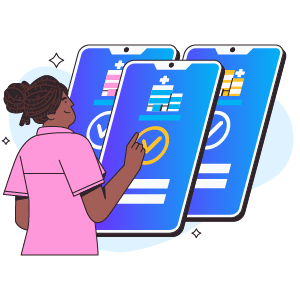The need for bilingual nurses continues to grow along with an increasingly diverse U.S. population.
Nurses know that good communication is the bedrock of safe patient care. Without clear communication, nurses are limited in their ability to collect vital information about patient history, current symptoms, and changes in status.
Many hospitals offer 24/7 on-demand video conferences with translator services, but these services are often unreliable. The tablets glitch or the connection is lost just when you’ve finally started. These technological challenges can deter nurses from using them, particularly for “quick” interactions, like giving a scheduled medication or assessing vital signs.
This reality makes the need for bilingual nurses an increasingly important issue for patient safety and quality care. This article will explore all aspects of bilingual nursing, including:
- Need for bilingual nurses
- When bilingual nurses are most needed
- Factors that increase the need for bilingual nurses
- Attracting bilingual nurses
- Willingness to learn a new language
Need for bilingual nurses
According to the U.S. Census Bureau, more than 20% of the U.S. population – 66 million people – speaks a language other an English at home. Of these 66 million people, 38% report speaking English less than “very well.” That’s more than 8% of the entire U.S. population that does not speak English fluently.
Benefits of bilingual nurses
While medical interpreters are highly trained members of the healthcare team, they can’t be everywhere at once. Bilingual nurses improve the efficiency of care as well as overall patient safety. This is achieved through improved communication and enhanced patient relationships.
No need to wait for information
Translators may visit the floor by appointment or in response to a request for help, but bilingual nurses can communicate as needs arise.
Translators are supposed to be present for every interaction with the patient, but this often isn’t practical. Demand is high for these services, including video-based interpreters. It can be hard to predict when interpreter services are needed, particularly for unscheduled interactions like assisting with toileting or responding to a call bell.
It can take longer to arrange translator services than provide the actual care, particularly when the nurse just needs to give a scheduled medication or update vital signs. Bilingual nurses are a solution to this problem.
Puts patient at ease
Patients frequently rely on nurses to clarify information and answer questions. Some patients may feel intimidated by the doctor and prefer to save their concerns for the nurse. Nurses who speak the patient’s language can help them communicate their needs more effectively.
Even if nurses do not become fluent in another language, basic proficiency can drastically improve the patient relationship. Simply being able to say “hello” and “good morning” can help the patient feel like their nurse really cares.
Get job matches in your area + answers to all your nursing career questions

When bilingual nurses are most needed
The need for bilingual nurses is exceptionally high throughout the patient care journey.
Admission
Bilingual nurses are particularly important in fast-paced areas, like the emergency room or urgent care. Immediate assessment is needed to ensure patients are triaged and diagnosed quickly and appropriately.
These nurses are invaluable during those times when the healthcare team needs to collect information from family members. Family members are often eager to translate for their loved ones, but without proper training in medical terms, these translations can fail to communicate vital information.
Patient care
Nurses spend more time with patients than anyone else on the healthcare team. A bilingual nurse can communicate key healthcare information when it’s needed most (e.g., assessments, medication administration, daily care).
Consent
It is important patients receive information and give consent in their preferred language. For scheduled procedures or surgery, a trained medical translator is enormously helpful. But for rapidly evolving situations, like a trauma admission to the ER, a bilingual nurse is invaluable.
Discharge
Discharge is an important opportunity for patient education and clarification of the plan of care. While a translator may be called for this discussion, questions can often arise after the doctor/translator team has left the room.
Bilingual nurses ensure all patient concerns are addressed, even those that arise outside of scheduled translator interactions.
Factors that increase the need for bilingual nurses
The need for bilingual nurses is highest in facilities with a large number of non-English speakers and in busy facilities that see many patients.
There is a particular need for bilingual nurses in metro areas along the coast, states along the U.S.-Mexico border, and the Michigan/Great Lakes region. These areas have the highest percentage of residents who speak a language other than English at home.
For example, 43% of California residents speak Spanish at home. In some U.S. counties, this number is even higher: over 85% of residents in McAllen, TX speak a language other than English at home.
While Spanish is currently the most common second language spoken at home in the United States (13.4% of the population), there is a growing need for bilingual nurses in other top languages, including Chinese, Arabic, French and French Creole, Tagalog, and Vietnamese.
Attracting bilingual nurses
There are a number of ways that employers can enable their nurses to study and maintain languages that benefit their key patient populations.
This might include reimbursement for language courses, higher payer for bilingual nurses, and paid time for language learning activities.
There are some language learning programs that offer continuing education credits for nurses. Another possibility is optional “maintenance pay” for nurses who can demonstrate continued proficiency in a target language.
Some hospitals also give staff an additional badge highlighting their language skills. This can motivate and honor nurses who have demonstrated proficiency in a second language.
Employers might also consider supporting staff in medical relief trips where they can practice their language on location.
Willingness to learn a new language
The best motivator for nurses to learn a new language is the obvious benefits this provides for patient care and safety.
It can help to consider the additional benefits of learning a second language, including:
- Potentially higher pay
- New job opportunities
- Possible continuing education units
- Smoother patient interactions with fewer requests for backlogged interpreter services
Nurses who speak a second language should consider negotiating for a pay increase. Consider the amount of time you spend speaking a second language and suggest this percentage as a starting ground for negotiations. For example, if you speak Portuguese 10% of the time at work, then consider asking for a 10% pay increase due to the vital language service you provide.
With these big potential benefits, it makes senses for nurses to highlight their language skills during interviews and to pursue language learning opportunities when possible.
Next steps
If you’re ready to put your language skills into action, then it’s time to create your profile with Incredible Health.
We’ll connect you with employers who are looking for nurses with critical language skills. The best part is that at Incredible Health, employers compete to hire you – not the other way around.
In fact, most of our nurses receive multiple job offers from top hospitals in under 20 days. Ready to find your dream job? We’ll help you every step of the way.
Get job matches in your area + answers to all your nursing career questions

Sources
- “Immigration and Diversity of Language in the United States.” ncbi.nlm.nih.gov. Accessed May 17, 2022.
- “What Languages Does the United States Speak?” census.gov. Accessed May 17, 2022.
- Photo by Oko_SwanOmurphy on iStock.
